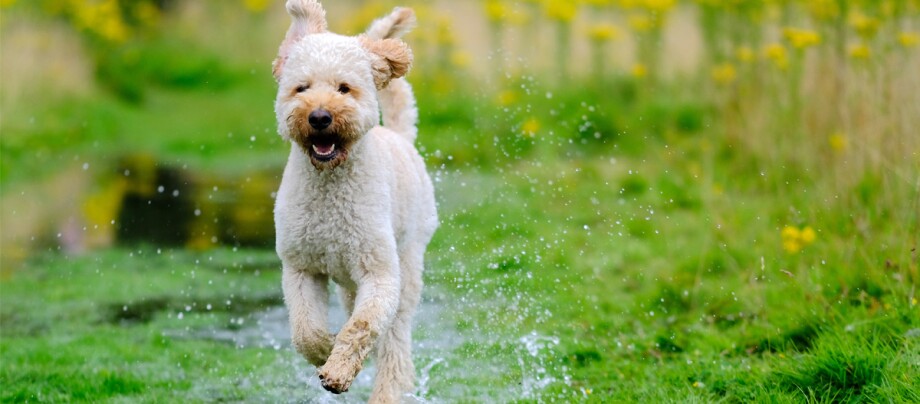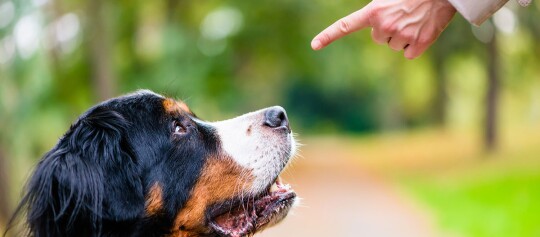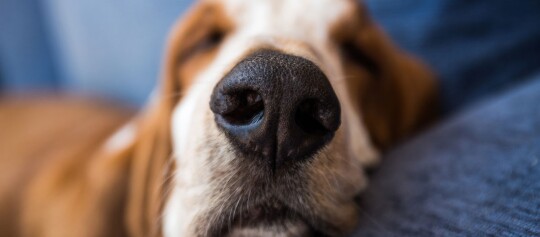Labradoodle – a cuddly companion with a big heart
18.11.2024 - Reading time: 8 minutes

The loveable nature of the Labrador combined with the non-shedding fur of the intelligent poodle – with some training, a Labradoodle is a great family dog for the everyday. With their great love for people firmly genetically anchored in both parent breeds, Labradoodles are also known for having an extremely friendly and positive nature. The cheerful character is packed into a medium-sized, curly and cuddly four-legged friend.
- Profile Labradoodle
- Looking for the ideal family dog
- Who is a Labradoodle suitable for?
- How much space does a Labradoodle need?
- Are Labradoodles suitable for allergy sufferers?
- How big is a Labradoodle and which coat colours can it have?
- Character of the Labradoodle
- Is a Labradoodle a good first dog?
- Training and looking after a Labradoodle
- How much does a Labradoodle cost?
- Buying a Labradoodle: What to consider
- How old do Labradoodles become?
- Taking care of a Labradoodle
Looking for the ideal family dog
Although there are hundreds of dog breeds out there, many dog-loving families find it difficult to find the perfect family dog. They need to fit into everyday life, be around knee height, playful, active, but not too demanding, cuddly, easy to train and – best of all – non-shedding. The Labrador meets the majority of these requests, except that it sheds vast amounts of hair in the house. Not like the poodle, which has a special fur: This doesn’t fall out, therefore spreading few allergens, making this kind of dog easy for most allergy sufferers to live with.
The Labradoodle combines the best of both breeds and is growing in popularity as a family dog. With the Australian Labradoodle, it is even on its way to becoming a new, recognised breed.
Who is a Labradoodle suitable for?
Labradoodles are friendly, gentle and social. These dogs are patient with children, making them suitable family dogs. Even in households that already have a dog or other animals, the Labradoodle usually gets on well. Aside from its attractive appearance, it is also eager to learn and intelligent: For example, if you enjoy dog sports or other training possibilities with dogs, a Labradoodle will be perfect for you.
NewsletterLabradoodle
Breed | Labradoodle |
Origin | Australia |
Classification | Labrador and Poodle mix (miniature or standard poodle) |
Size | 30 to 71 centimetres shoulder height |
Weight | 10 to 40 kilogram |
Physique | attractive, muscular and usually square with long legs |
Eyes | brown or black with a curious look |
Ears | short or longer hanging ears |
Coat and colour | three hair types from fine curls to almost straight, in many colours such as beige, white, brown, black or brindled |
Special features | suitable for those with dog allergies if born with poodle fur (test before buying) |
Nature | cheerful, intelligent, attentive and playful |
Care | regular brushing and grooming depending on fur type |
Health | breed-related disposition for eye, elbow and hip joint diseases |
We have the best products for your Labradoodle!
How much space does a Labradoodle need?
Labradoodles have a lot of energy and love being active – if you yourself enjoy getting outdoors, jogging, cycling or taking long walks on a daily basis, then you will get on great with this dog. For older people, who may not be great at walking longer distances, they may be less of an option in some cases. These dogs also don’t like to be left alone for too long – they need attention from their owners and social connection. Otherwise, there is a risk of the Labradoodle getting up to no good when left alone at home.
Are Labradoodles suitable for allergy sufferers?
It is sometimes believed that Labradoodles are ideal for allergy sufferers or “allergy-free”. In general, a Labradoodle may be an option for allergy sufferers as it loses little hair. To be more precise, however, it is not the animal hair, but allergens from the saliva and skin flakes of the animals that trigger the allergy. And allergy sufferers do, of course, come into contact with these with Labradoodles. The advantage of the Labradoodle is first and foremost that it sheds little and therefore spreads few allergens in the apartment. Depending on how severe the allergy is in the individual case, however, a Labradoodle can lead to problems. Before allergy sufferers buy a Labradoodle, in case of doubt, it is recommended to obtain an assessment from a doctor beforehand. Because nothing is more heartbreaking for dog and owner than having to give up a much loved animal.
How big is a Labradoodle and which coat colours can it have?
Labradoodles also need plenty of space and freedom of movement, meaning a small urban apartment may not be the right option, as depending on the size of the parents, a labradoodle can reach a shoulder height of up to 70 centimetres. An alternative option may then be Mini Labradoodles with a shoulder height of around 35 to 45 centimetres. The miniature version of the Labradoodle is smaller, because it is cross-bred with Miniature Poodles. However, as these are ultimately mixed with Labrador Retrievers, i.e. with a relatively large breed, it is still not easy to predict for sure how big your Mini Labradoodle will actually be when fully grown.
The Labradoodle’s appearance varies, as the popular dogs come in various colours such as white or cream, red, brown, apricot, black and grey.
Character of the Labradoodle
Labradoodle puppies receive their characteristics from both parent breeds. But it is possible for one to be more prominent. The Labrador is considered a clown among dogs. It is always in good spirits, happy to play, even-tempered in character and a true friend to children. The short-haired breed, which is part of the hound family, may prove tumultuous and is also considered very greedy.
Poodles are a little more cautious, but also very friendly and up for anything. Because Miniature Poodles are slightly more alert and more jittery than Standard Poodles, Labradoodles have slight differences in terms of activity level, depending on the parents. Labradors and Poodles alike have been bred for a life without hunting for a long time already. Nevertheless, a certain degree of hunting is possible with Labradoodles. Fetching exercises or tasks such as scent work satisfy the willingness of the friendly mixed breed to work while improving obedience.
Is a Labradoodle a good first dog?
As a teachable, social, patient and friendly dog, a Labradoodle is also a good dog for first-time owners. Nevertheless, like every dog, it needs someone that understands it and can meet its needs. To keep the dog happy with its everyday life, first-time owners are always recommended visiting a dog school with their Labradoodle puppies or seeking support from a dog trainer. As such, both of you can learn how to live together harmoniously right from the start. It is important to keep training consistent from day one. Because the puppy phase is where you lay the foundation for how the dog will behave in later life. Vice versa, unpleasant behaviours in adult dogs are difficult to unlearn. If your Labradoodle grows up with children, it is good if they too pull together in terms of growing up. Older children can often even have a certain level of responsibility, such as not feeding the dog anything from the table. The younger your children, the more important it is to keep a watchful eye on them and the dog.
Training and looking after a Labradoodle
Like its parent breeds, the Labradoodle loves human company. The usually curly-haired dogs love to be at the heart of the action. That’s why it is important to practice staying alone from day one, but without overwhelming them. When out and about, aim to keep the doodle’s love for humans under control so that they don’t jump up or run at anyone in their excitement. Due to the breed’s characteristics, the Labradoodle comes with a major will to please. This results in great willingness to cooperate with people. It is therefore easy to train and with some consistency, becomes an attentive, cheerful companion and family dog. Labradoodles are also suitable for demanding tasks in dog sport, search dog work and as a therapy or companion dog.
How much does a Labradoodle cost?
There is no general answer for how much a Labradoodle costs, and this can vary from breeder to breeder. If you want to buy a Labradoodle puppy, you should expect a price of at least €1,000, with an Australian Labradoodle possibly even over double that.
Buying a Labradoodle: What to consider
If you want to buy a Labradoodle, finding a reputable breeder is key. With the popularity of a dog breed, the number of “black sheep” among breeders also usually rises. You can identify a reputable breeder in that, among other things, they show you all dogs, including of course the mother of the Labradoodle puppies. They respond to your questions openly and ask some of their own, as serious breeders want to see their Labradoodle puppies in good hands at all costs. If the breeder’s Labradoodles live with family contact, this is ideal for the dogs. But be sceptical if the dogs are kept in a kennel or shed. Make sure that the dogs are living in hygienically sound conditions. A responsible breeder also doesn’t give away its Labradoodle puppies until they are the right age; this should be no fewer than twelve weeks. It is ideal if you are able to visit the breeder a few times before deciding to buy a Labradoodle puppy. It should also have the necessary vaccinations and deworming treatments. On the other hand, you should be suspicious if a breeder only shows you one animal and puts you under pressure to buy. Dealers offering dogs in backyards or in car parks are incredibly dubious! Do not be tricked into buying, even out of pity.
How old do Labradoodles become?
With good genetic conditions, Labradoodles reach an age of 13 to 15 years. The life expectancy of a dog, however, ultimately depends on many individual factors, including proper care and diet, as well as appropriate veterinary care. Existing diseases in the parents of a Labradoodle may indicate specific predispositions.
Taking care of a Labradoodle
Most Labradoodles have a typical Poodle coat: It is curly and constantly grows without falling out. These dogs have to be brushed and groomed regularly. It is solely up to you which haircut you want your dog to have. Whether a wild teddy cut, long curls or a practical cut to a few millimetres – a Labradoodle is wildly versatile. The fur must be trimmed around every six to eight weeks.

